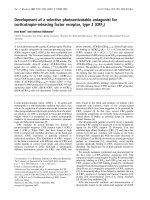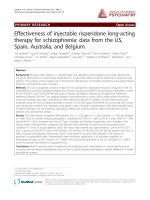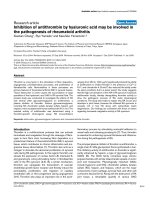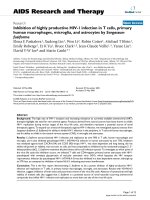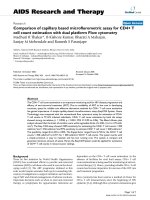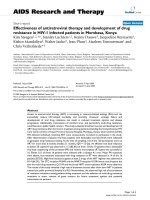Báo cáo y học: "Effectiveness of injectable risperidone long-acting therapy for schizophrenia: data from the US, Spain, Australia, and Belgium" ppt
Bạn đang xem bản rút gọn của tài liệu. Xem và tải ngay bản đầy đủ của tài liệu tại đây (304.1 KB, 7 trang )
PRIMARY RESEARCH Open Access
Effectiveness of injectable risperidone long-acting
therapy for schizophrenia: data from the US,
Spain, Australia, and Belgium
Tim Lambert
1†
, José M Olivares
2†
, Joseph Peuskens
3†
, Cherilyn DeSouza
4†
, Chris M Kozma
5†
, Patrick Otten
6†
,
Concetta Crivera
7*†
, An Jacobs
8†
, Wayne Macfadden
9†
, Lian Mao
10†
, Stephen C Rodriguez
7†
, Riad Dirani
7†
and
Kasem S Akhras
11†
Abstract
Background: Because wide variations in mental health care utilization exist throughout the world, determining
long-term effectiveness of psychotropic medications in a real-world setting would be beneficial to physicians and
patients. The purpose of this analysis was to describe the effectiveness of injectable risperidone long-acting therapy
(RLAT) for schizophrenia across countries.
Methods: This was a pragmatic analysis of data from two prospective observational studies conducted in the US
(Schizophrenia Outcomes Utilization Relapse and Clinical Evaluation [SOURCE]; ClinicalTrials.gov registration number
for the SOURCE study: NCT00246194) and Spain, Australia, and Belgium (electronic Schizophrenia Treatment
Adherence Registry [eSTAR]). Two separate analyses were performed to assess clinical improvement during the
study and estimate psychiatric hospitalization rates before and after RLAT initiation. Clinical improvement was
evaluated using the Clinical Global Impressions-Severity (CGI-S) and Global Assessment of Functioning (GAF) scales,
and change from baseline was evaluated using paired t tests. Psychiatric hospitalization rates were analyzed using
incidence densities, and the bootstrap resampling method was used to examine differences between the pre-
baseline and post-baseline periods.
Results: The initial sample comprised 3,069 patients (US, n = 532; Spain, n = 1,345; Australia, n = 784; and Belgium,
n = 408). In all, 24 months of study participation, completed by 39.3% (n = 209), 62.7% (n = 843), 45.8% (n = 359),
and 64.2% (n = 262) of patients from the US, Spain, Australia, and Belgium, respectively, were included in the
clinical analysis. Improvements compared with baseline were observed on both clinical assessments across
countries (P < 0.001 at all post-baseline visits). The mean improvement was approximately 1 point on the CGI-S
and 15 points on the GAF. A total of 435 (81.8%), 1,339 (99.6%), 734 (93.6%), and 393 (96.3%) patients from the US,
Spain, Australia, and Belgium, respectively, had ≥1 post-baseline visit and were included in the analysis of
psychiatric hospitalization rates. Hospitalization rates decreased significantly in all countries regardless of
hospitalization status at RLAT initiation (P < 0.0001) and decreased significantly in the US and Spain (P < 0.0001)
when the analysis was limited to outpatients only.
Conclusions: RLAT in patients with schizophrenia was associated with improvements in clinical and functional
outcomes and decreased hospitalization rates in the US, Spain, Austral ia, and Belgium, despite differences in health
care delivery systems.
* Correspondence:
† Contributed equally
7
Ortho-McNeil Janssen Scientific Affairs, LLC, Titusvi lle, NJ, USA
Full list of author information is available at the end of the article
Lambert et al. Annals of General Psychiatry 2011, 10:10
/>© 2011 Lambert et al; licensee BioM ed Central Ltd. This is an Open Access article distributed under the terms of the Creative Commons
Attribution License ( which permits unre stricted use, distribution, and reproduction in
any medium, provided the original work is properly cited.
Background
According to analyses by the World Health Organiza-
tion (WHO), wide variatio ns exist in mental health care
delivery systems across the world; for example, only 68%
of countries have a mental health care policy [1]. Coun-
tries differ with respect to the primary method of finan-
cing mental health care (that is, out-of-pocket payment,
tax-based, social insurance, private insurance, or exter-
nal grants) and available funds allocated for mental
health care [1]. Schizophrenia is a particularly debilitat-
ing mental illness with high human and societal costs.
Patients and their families cope with symptom fluctua-
tions, poor social and occupational functioning, and the
periodic need for psychia tric hospitalization due to
relapse [2,3]. For society, schizophrenia is one of the
most expensive mental illnesses to treat, with psychiatric
hospitalization being a key driver of costs [4].
Continuous antipsychotic therapy is recommended to
limit disease severity. However, with oral antipsychotic
medication, non-adherence is present in approximately
half of patients [5]. Partial adherence (taking some but
not all medication as prescribed) is even more prevalent,
occurring in approximately 9 out of 10 patients [6]. The
impact of poor medication adherence is substa ntial and
includes increased symptom levels; a greater risk for vio-
lence, arrest, and poor functioning; higher rates of sub-
stance abuse and alcohol-related problems; increased
risk of psychiatric hospit alization and increased hospital
costs [6-10]. A recent (2005) estimate of US costs due
to medication non-adherence in patients with schizo-
phrenia was $1.479 billion [11]. Additionally, each
relapse episode predisposes the patient to further epi-
sodes, whereas fewer episode s are associated with better
long-term outcomes [12].
Long-acting formulations can improve adherence by
ensuring medication delivery between injections. Com-
pared with oral medications, depot formulations offer
better control over dose adjust ments, more predictable
and consistent p lasma drug concentrations, and lower
rates of patient relapse [13,14] . Risperidone long-acting
therapy (RLAT) is the first such treatment to combine a
long-acting i njectable formulation with the efficacy of a
second-generation antipsychotic. The short-term and
long-term efficacy and safety of RLAT in patients with
schizophrenia have been demonstrated in randomized
controlled studies [15-18], and one open-label study (N
= 397) found that the annual rehospitalization rate
decreased from 38% to 12% in those receiving RLAT (P
< 0.001) [19].
The objective of this pragmatic analysis was to exam-
ine the long-term effectiveness of RLAT in real-world
clinical practice in dif ferent countries. Data for this ana-
lysis were from two 2-year RLAT observational studies:
the Schizophrenia Outcomes Utilization Relapse and
Clinical Evaluation (SOURCE) study, conducted in the
US, and the electronic Schizophrenia Treatment Adher-
ence Registry (eSTAR), conducted in Spain, Australia,
and Belgium.
The health care systems in these countries vary con-
siderably. The US spends 6% of its total health budget
on mental health care [1]. The primary sources of finan-
cing are private insurance, tax-based insurance, and out-
of-pocket expenditures paid by the patient or family.
When private insurance benefits are exhausted, patients
move to the public sector, where Medicaid and Social
Security Disability Insurance provide a safety net [1].
Spain does not have a specific budget allocation for
mental health care services, so details about mental
health care expenditures in that country are not avail-
able. T he Spanish health care system provides universal
access to medical and mental health care services for all
of its citizens [1]. Australia has a national health care
system with universal access for all citizens. It spends
10% of its total health budget on mental health care,
and the primary sourc e of mental health care financing
is tax based [1]. Belgium spends 6% of its total health
budget on mental health care services, which are a part
of the primary health care system. The primary source
of mental health care financing is through social insur-
ance [1].
Methods
SOURCE and eSTAR designs
Data from the two studies were collected under similar
protocols, which imposed no study-mandated interven-
tions except for initiation of RLAT. The SOURCE study
(CR005035) was conducted from September 2004 to
October 2007 in community mental health centers and
Veterans Affairs Medical Centers in the US. In eSTAR
(CR005548), a multinational study conducted in 17
countrie s, participating physicians enrolled patients after
treatment was initiated with RLAT during the patient’s
routine clinical management. Patients were enrolled in
eSTAR between December 2003 and July 2009. Because
Spain, Belgium, and Australia completed 24 months of
patient treatment, t he data from these three countries
only were used for this analysis. Institutional review
boards or e thics committees, as appropriate, provided
approval of the respective study protocols.
Participants
Participants were male or female patients with schizo-
phrenia, aged 18 years or older, who required initiation
of RLAT as determined by their physicians. Pregnant or
breastfeeding patients and patients considered treatment
resistant were exclude d. All pati ents (or thei r legal
Lambert et al. Annals of General Psychiatry 2011, 10:10
/>Page 2 of 7
representatives) provided written informed consent
before participation in the studies.
Treatment
The recommended RLAT dose is 25 mg administered
every 2 weeks. The initial dose chosen for each patient,
however, was based on the individual physician’ sjudg-
ment. Any subsequent decisions regarding treatment
(including stopping, starting, or changing RLAT and
prescribing concomitant psychiatric medications) were
made as deemed appropriate by the treating physician.
Data collection
Retrospective data o n psychiatric hospitalizations were
determined for the 12-month period before enrollment.
At baseline (initial dose of RLAT), demographic infor-
mation was collected and the Clinical Global Impres-
sions-Severity (CGI-S) [20] and Global Assessment of
Functioning (GAF) [21] were assessed. The CGI-S is a
seven-point scale ranging from 1 (normal, not at all ill)
to 7 (severely ill). The GAF is a single-item rating of the
patient’s psychological, social, and occupational func-
tioning, with scores ranging from 0 to 100 and higher
scores indicating better functioning. Hospitalization
rates and CGI-S and GAF scores were determined at 3-
month intervals after the baseline visit, up to month 24.
Statistical methods
During the study, CGI-S and GAF scores wer e rep orted
for all patients who completed 24 months of treatment.
Change from baseline in CGI-S and GAF scores was
evaluated using paired t tests. All tests were two tailed
and conducted at the 5% significance level. No adjust-
ments were made for multiplicity.
Data were analyzed for each country independently.
Psychiatric hospitalization rates were analyzed using
incidence densities, defined as the total number of
events for the study population divided by the total
length of treatment i n years. Patients who had only a
baseline visit with no treatment information were
excluded from the analysis. This analysis included 12
months of pre-baseline data and 24 months of post-
baseline data, adjusted for 1 year. The bootstrap resam-
pling method was use d to calculate 95% confidence
intervals to e xamine differences between the pre-base-
line and post-baseline periods. To account for the differ-
ences between countries in the percentage of patients
hospitalized at base line, incidence ratios were calculated
for (1) all patients regardless of hospitalization status
and (2) outp atien ts. For patients w ho were hospitalized
when the initial dose of RLAT was administered, the
current hospitalization was considered as occurring
before baseline.
Results
Patients
Baseline demographic and clinical characteristics for the
patients who completed 24 months of treatment are
included in Table 1. In all, 24 months of treatment were
completed by 39.3% of patients in the US, 62.7% in
Spain, 45.8% in Australia, and 64.2% in Belgium.
Approximately two-thirds of the patie nts in all countries
were male. The mean age ranged from 38.8 years
(Spain) to 42.4 years (US). Noteworthy differences were
observed in disease duration, with the mean time since
diagnosis ranging from 10.6 years (Belgium) to 18.1
years (US). Baseline mean CGI-S scores were similar in
all countries and indicated patients were moderately to
markedly ill. Baseline mean GAF scores were slightly
higher in the US and Spain than in Belgium and Austra-
lia, but patients in all countries had moderate to severe
functional impairment (mean scores ranged from 42.3
to 48.3) (Table 1).
The initial dose of RLAT varied considerably from
country to country. RLAT 25 mg was the most common
initial dose, used in 75.4% o f all patients in the US,
43.2% in Spain, 90.8% in Au stralia, and 49.0% in Bel-
gium. At the end of the study, the general trend was
toward higher doses. The final dose, based on all
patients in the study at 24 months, was 25 mg in 20%
to 35% of all patients and 50 mg in 40.2% of US
patients, 43.5% of Spanish patients, 36.2% of Australian
patients, and 37.7% of Belgian patients.
Change from baseline on CGI-S and GAF scores
Mean (SD) CGI-S scores at baseline were 4.6 (1.3), 4.6
(0.9), 4.5 (1.0), and 4.7 (1.0) in patients from the US,
Spain, Australia, and Belgium, respectively. Mean CGI-S
scores improved significantly (P < 0.001) in every coun-
try at all post-baseline visits up to 2 4 months. Changes
were similar for patients regardless of country (Figure
1); mean scores decreased (improved) by approximately
0.6 to 0.8 points at 3 months and by 0.9 to 1.2 points at
24 months.
Mean (SD) GAF scores at baseline were 48.3 (14 .6),
47.8 (15.6), 42.3 (14.5) and 43.3 (12.0) in patients from
the US, Spain, Australia, and Belgium, respectively. GAF
score s improved in each group over time; changes from
baseline were statistically significant (P < 0.001) at all
post-baseline visits up to 24 months (Figure 2). Across
countries, scores improved by 6.9 to 9.6 points at
3 months and by 15.2 to 16.4 points a t 24 months
(Figure 2).
Psychiatric hospitalization
Demographic and clinical characteristics at baseline for
patients who had at least 1 post-baseline visit and were
Lambert et al. Annals of General Psychiatry 2011, 10:10
/>Page 3 of 7
evaluated for hospitalization were s imilar to those of
patients who completed 24 months of treatment (Table
1). The percentage of patients hospitalized in the year
before RLAT initiation differed considerably, with the
highest rates in Australia (76.8%) and Belgium (71.2%)
and the lowest rates in the US (39.3%) and Spain
(35.0%).
Psychiatric hospitalization was assessed in two groups of
patients: (1) all patients regardless of hospitalization status
at baseline and (2) outpatients (Table 2). The analysis of
outpatients was performed to assess similar patient popu-
lations in the four countries, given the large between-
country differences in the proportion hospitalized at base-
line. The number of hospitalizations per person-year
Table 1 Demographic and clinical characteristics at baseline
US Spain Australia Belgium
Patients, n 532 1,345 784 408
Patients who completed 24 months of treatment (evaluated for clinical measures)
Patients with 24 months of follow-up, n (%)
a
209 (39.3) 843 (62.7) 359 (45.8) 262 (64.2)
Age in years, mean (SD) 42.4 (12.3) 38.8 (11.2) 39.3 (13.0) 41.3 (13.3)
Male gender, % 64.1 63.2 68.5 63.7
Years since diagnosis, mean (SD) 18.1 (11.3) 13.1 (9.8) 12.2 (10.4) 10.6 (10.6)
CGI-S score, mean (SD) 4.6 (1.3) 4.6 (0.9) 4.5 (1.0) 4.7 (1.0)
GAF score, mean (SD) 48.3 (14.6) 47.8 (15.6) 42.3 (14.5) 43.3 (12.0)
Patients with ≥1 post-baseline visit (evaluated for psychiatric hospitalization rate)
Patients with ≥1 post-baseline visit, n (%)
a
435 (81.8) 1,339 (99.6) 734 (93.6) 393 (96.3)
Age in years, mean (SD) 41.9 (12.6) 38.4 (11.2) 37.1 (12.5) 40.3 (13.3)
Male gender, % 66.7 63.6 69.9 62.8
Years since diagnosis, mean (SD) 17.6 (12.1) 12.6 (9.5) 10.7 (9.5) 9.5 (10.2)
Hospitalized in the year before RLAT initiation, % 39.3 35.0 76.8 71.2
CGI-S score, mean (SD) 3.9 (1.2) 4.6 (0.9) 4.6 (1.0) 4.7 (1.0)
GAF score, mean (SD) 53.1 (13.7) 46.9 (15.2) 42.7 (14.4) 43.6 (12.5)
a
Based on total patient population.
CGI-S = Clinical Global Impressions—Severity; GAF = Global Assessment of Functioning; RLAT = risperidone long-acting therapy.
Time (months)
Mildly ill
Moderately ill
Markedly ill
2
3
4
5
BL 3 6 9 1215182124
US Spain Australia Belgium
Mean CGI-S Score
Figure 1 Mean Clinical Global Impressions—Severity (CGI-S) scores by visit and country for patients who had 24 months of treatment.
All changes from baseline, P < 0.001, paired t test. BL = baseline.
Lambert et al. Annals of General Psychiatry 2011, 10:10
/>Page 4 of 7
decreased significantly (P < 0.0001) in all countries when
patients were considered regardless of baseline hospitaliza-
tion status, with a percentage decrease of 54.9% in the US,
64.4% in Spain, 46.3% in Australia, and 52.4% in Belgium.
When the analysis was limited to outpatients only, the
number of hospitalizations decreased significantly for
patients from the US and Spain, by 55.9% and 56.8%,
respectively. The percentage decreases were 17.1% in Aus-
tralia and 22.4% in Belgium (Table 2).
Discussion
This analysis was con ducted to examine the effective-
ness of RLAT for patients with schizophrenia in real-
world clinical settings in the US, Spain, Australia, and
Belgium. The patients’ overall clinical severity and func-
tional levels at baseline were relatively similar across
countries. Improvement in disease severity and function-
ing were seen in all patient groups and was maintained
up to 24 months of follow-up. These results, consistent
with those of other naturalistic studies w ith RLAT
[22-24], further suggest that RLAT is effective across
health care delivery systems.
The discontinuation rate associated with oral antipsy-
choticsisknowntobehigh[25].Inthisanalysis,com-
pletion rates over 24 months with RLAT ranged from
39.3% in the US to 62.7% in Spain. The variation in
Mean GAF Score
Time (months)
Some mild symptoms
OR
some difficulty in
functioning
Moderate symptoms
OR
moderate difficulty in
functioning
Serious symptoms
OR
any serious impairment
in functioning
40
50
60
70
BL 3 6 9 12 15 18 21 24
US Spain Australia Belgium
Figure 2 Mean Global As sessment of Functioning (GAF) scores by visit and country for patients who had 24 months of treatment. All
changes from baseline, P < 0.001, paired t test. BL = baseline.
Table 2 Psychiatric hospitalizations 12 months before RLAT initiation for patients with ≥1 post-baseline visits
(incidence density ratios)
Hospitalization
status at
baseline
US Spain Australia Belgium
All patients
a
Patients not
hospitalized
at baseline
All patients
a
Patients not
hospitalized
at baseline
All patients
a
Patients not
hospitalized
at baseline
All patients
a
Patients not
hospitalized
at baseline
Patients, n 435 413 1,339 1,220 734 354 393 173
Before baseline visit 0.63 0.59 0.45 0.37 1.34 0.82 1.05 0.49
Change
(95% CI)
b
-0.35
c
(-0.44 to -0.26)
-0.33
c
(-0.42 to -0.24)
-0.29
c
(-0.33 to -0.24)
-0.21
c
(-0.25 to -0.17)
-0.62
c
(-0.74 to -0.50)
-0.14
(-0.29 to 0.04)
-0.55
c
(-0.67 to -0.44)
-0.11
(-0.26 to 0.03)
Percentage change -55.6% -55.9% -64.4% -56.8% -46.3% -17.1% -52.4% -22.4%
Patients had data for the post-baseline period up to the time of study discontinuation. Estimates for the pre-baseline and post-baseline periods may be based on
different observation time periods within patients. Hospitalizations occurring before study start or after the last study visit were not included in the analysis.
a
For patients who were hospitalized when initiating RLAT, the current hospitalization was considered as occurring before baseline.
b
Confidence intervals and P values were derived using the bootstrap resampling method.
c
P < 0.0001 for change in hospitalization.
CI = confidence interval; RLAT = risperidone long-acting therapy.
Lambert et al. Annals of General Psychiatry 2011, 10:10
/>Page 5 of 7
discontinuation rates among the four countries may be
due to differences in access to treatment, social support
(for example, in patients who live alone), and cost (for
example, in Spain, RLAT is free for most patients).
RLAT was associated with decreased psychiatric hos-
pitalization in all four countries, when patients were
considered regardless of hospitalization status at base-
line: hospitalizations per person-year decreased by
approximately half in the year after initiation of RLAT,
compared with the previous year. When the analysis
was limited to outpatients at baseline, hospitalizations
decreased significantly in the US and Spain. These data
suggest the difficulties of assessing the treatment effect
on inpatient status for patients with schizophrenia
across varying health care systems. For example, 95% of
patients in the US were outpatients at baseline, com-
pared with only 48% in Australia. Beyond the individu al
patient factors that determine hospitalization status,
such as disease severity, these results suggest major
health care system difference regarding hospitalizations
and duration of hospitalization. The intent of the analy-
sis was to compare populations with a similar clinical
status (outpatients at baseline); however, the high rates
of baseline hospitalizations in Australia and Belgium
more likely reflect differences in practice rather than
clinical status across populations.
Randomized controlled studies provide the highest
standard of evidence for the efficacy and safety of treat-
ments; however, several disadvantages limit the general-
izability of results. Most studies in schizophrenia are
relatively short, even though patients require lifelong
treatment. Further, because populations are small and
limited by restrictive enrollment criteria, they may not
be representative of clinical practice. Pragmatic studies,
such as those described here, provide complementary
data that evaluate whether an intervention works in
real-life situations [26]. Pragmatic studies of patients
with schizophrenia include a broader patient range, lar-
ger numbers of patients, and longer treatment durations
and have provided insights into the effectiveness of anti-
psychotic treatment [27-30].
Several limitations should be noted. Because the
eSTAR and SOURCE studies were not randomized,
establishing causal relationships be tween RLAT and
improvements in effectiveness measures is not possible.
Further, patients with only a baseline visit were excluded
from the analysis of hospitalization; however, this group
comprised only a small subset of patients in the total
sample (n = 168; 5.5%). Also, information on hospitali-
zation in the 12 months before RLAT initiation was col-
lected retrospectively. These data relied on the accuracy
of historical chart information, and hospitalization
might have been underreported. Data were analyzed
only for patients who completed 24 months of
treatment and who had a baseline and a 24-month value
on the CGI-S and GAF scales, which may have intro-
duced selection bias. Improvements in effectiveness
measures were not statistically analyzed for differences
between the participating countries because certain fac-
tors that might not be properly adjusted or controlled
might contribute to country differences.
Conclusions
Pragmatic studies are valuable for capturing real-world
clinical practices across different health care settings
and can be used to inform health care decision makers.
Despite substantial variability among health care sys-
tems, treatment with RLAT resulted in improved func-
tioning and decreased psychiatric hospitalization rates in
patients with schizophrenia from the US, Spain, Austra-
lia, and Belgium.
Acknowledgements
Financial support for this manuscript was provided by Ortho-McNeil Janssen
Scientific Affairs, LLC, Titusville, NJ, USA. The SOURCE study was supported
by Ortho-McNeil Janssen Scientific Affairs, LLC; the eSTAR study was
supported by Janssen Cilag. The authors wish to thank Matthew Grzywacz,
PhD, Mariana Ovnic, PhD, and ApotheCom (funding supported by Ortho-
McNeil Janssen Scientific Affairs, LLC, Titusville, NJ, USA) for technical
assistance in the development and submission of this manuscript.
Author details
1
University of Sydney, Sydney, Australia.
2
Hospital Meixoeiro, Complejo
Hospitalario Universitario de Vigo, Vigo, Spain.
3
Universitair Psychiatrisch
Centrum, KU Leuven Campus UC-St. Jozef, Kortenberg, Belgium.
4
Veterans
Affairs Medical Center, Kansas City, MO, USA.
5
University of South Carolina,
Columbia, SC, USA.
6
SGS Life Science Services, Mechelen, Belgium.
7
Ortho-
McNeil Janssen Scientific Affairs, LLC, Titusville, NJ, USA.
8
Johnson & Johnson
Pharmaceutical Services, Beerse, Belgium.
9
Formerly Ortho-McNeil Janssen
Scientific Affairs, LLC, Titusville, NJ, USA.
10
Johnson & Johnson
Pharmaceutical Research and Development, LLC, Titusville, NJ, USA.
11
Johnson & Johnson Pharmaceutical Services, Raritan, NJ, USA.
Authors’ contributions
TL, JMO, JP, and CD were involved in the interpretation of data, and critical
drafting and revising of the manuscript for important intellectual content.
PO, CMK, CC, SCR, RD, WM, LM, AJ, and KSA contributed to the conception
and design, acquisition of data, analysis and interpretation of data, and
drafting of the manuscript and its critical revision for important intellectual
content.
Competing interests
TL is a consultant for Janssen, Eli Lilly, and Pfizer; has received grant-research
support from Janssen; and is a member of a speaker bureau for Janssen, Eli
Lilly, Pfizer, and AstraZeneca. JMO is a member of regional, national, and
international advisory boards for Janssen-Cilag, Eli Lilly, AstraZeneca, and
Bristol-Myers Squibb; is involved in designing and participating in clinical
trials for Janssen-Cilag, Eli Lilly, AstraZeneca, Pfizer, Lundbeck,
GlaxoSmithKline, and Bristol-Myers Squibb; and has receiv ed educational
grants for research, honoraria, and travel support for activities as a
consultant/advisor and lecturer/faculty member for Janssen-Cilag, Eli Lilly,
AstraZeneca, Pfizer, Lundbeck, GlaxoSmithKline, Novartis, and Bristol-Myers
Squibb. JP is a consultant and member of the speaker bureaus for and
received grant-research support from Janssen-Cilag, Eli Lilly, AstraZeneca,
Lundbeck, and Bristol-Myers Squibb. CMK is a consultant for Ortho-McNeil
Janssen Scientific Affairs, LLC. CC, SCR, and RD are employees of Ortho-
McNeil Janssen Scientific Affairs, LLC, and Johnson & Johnson stockholders.
WM was an employee of Ortho-McNeil Janssen Scientific Affairs LLC at the
time of this analysis. LM is an employee of Johnson & Johnson
Lambert et al. Annals of General Psychiatry 2011, 10:10
/>Page 6 of 7
Pharmaceutical Research and Development, LLC, and a Johnson & Johnson
stockholder. AJ is an employee of Johnson & Johnson Pharmaceutical
Services and a Johnson & Johnson stockholder. KSA was an employee of
Johnson & Johnson Pharmaceutical Services at the time of this analysis. CD
and PO have no competing interests.
Received: 29 October 2010 Accepted: 4 April 2011
Published: 4 April 2011
References
1. World Health Organization: World Mental Health Atlas Geneva, Switzerland:
WHO; 2005.
2. Eli Lilly and Company: Keeping care complete: a caregivers’ perspective on
mental illness and wellness. An international survey Indianapolis, IN: Eli Lilly
and Company; 2010.
3. Eli Lilly and Company: Keeping care complete: a physicians’ perspective on
mental illness and wellness. An international survey: International findings
sheet Indianapolis, IN: Eli Lilly and Company; 2010.
4. Zhu B, Ascher-Svanum H, Faries DE, Peng X, Salkever D, Slade EP: Costs of
treating patients with schizophrenia who have illness-related crisis
events. BMC Psychiatry 2008, 8:72.
5. Lacro JP, Dunn LB, Dolder CR, Leckband SG, Jeste DV: Prevalence of and
risk factors for medication nonadherence in patients with schizophrenia:
a comprehensive review of recent literature. J Clin Psychiatry 2002,
63:892-909.
6. Docherty JP, Grogg AL, Kozma C, Mahmoud R: Antipsychotic maintenance
in schizophrenia: partial compliance and clinical outcome. Presented at
The American College of Neuropsychopharmacology 41st Annual Meeting San
Juan, Puerto Rico; 2002.
7. Gilmer TP, Dolder CR, Lacro JP, Folsom DP, Lindamer L, Garcia P, Jeste DV:
Adherence to treatment with antipsychotic medication and health care
costs among Medicaid beneficiaries with schizophrenia. Am J Psychiatry
2004, 161:692-699.
8. Valenstein M, Copeland LA, Blow FC, McCarthy JF, Zeber JE, Gillon L,
Bingham CR, Stavenger T: Pharmacy data identify poorly adherent
patients with schizophrenia at increased risk for admission. Med Care
2002, 40:630-639.
9. Weiden PJ, Kozma C, Grogg A, Locklear J: Partial compliance and risk of
rehospitalization among California Medicaid patients with schizophrenia.
Psychiatr Serv 2004, 55:886-891.
10. Ascher-Svanum H, Faries DE, Zhu B, Ernst FR, Swartz MS, Swanson JW:
Medication adherence and long-term functional outcomes in the
treatment of schizophrenia in usual care. J Clin Psychiatry 2006,
67:453-460.
11. Sun SX, Liu GG, Christensen DB, Fu AZ: Review and analysis of
hospitalization costs associated with antipsychotic nonadherence in the
treatment of schizophrenia in the United States. Curr Med Res Opin 2007,
23:2305-2312.
12. Lieberman JA, Sheitman BB, Kinon BJ: Neurochemical sensitization in the
pathophysiology of schizophrenia: deficits and dysfunction in neuronal
regulation and plasticity. Neuropsychopharmacology 1997, 17:205-229.
13. Kane JM, Aguglia E, Altamura AC, Ayuso Gutierrez JL, Brunello N,
Fleischhacker WW, Gaebel W, Gerlach J, Guelfi JD, Kissling W, Lapierre YD,
Lindstrøm E, Mendlewicz J, Racagni G, Carulla LS, Schooler NR: Guidelines
for depot antipsychotic treatment in schizophrenia. European
Neuropsychopharmacology Consensus Conference in Siena, Italy. Eur
Neuropsychopharmacol 1998, 8:55-66.
14. Schooler NR: Relapse and rehospitalization: comparing oral and depot
antipsychotics. J Clin Psychiatry 2003, 64:14-17.
15. Kane JM, Eerdekens M, Lindenmayer JP, Keith SJ, Lesem M, Karcher K: Long-
acting injectable risperidone: efficacy and safety of the first long-acting
atypical antipsychotic. Am J Psychiatry
2003, 160:1125-1132.
16. Chue P, Eerdekens M, Augustyns I, Lachaux B, Molcan P, Eriksson L,
Pretorius H, David AS: Comparative efficacy and safety of long-acting
risperidone and risperidone oral tablets. Eur Neuropsychopharmacol 2005,
15:111-117.
17. Simpson GM, Mahmoud RA, Lasser RA, Kujawa M, Bossie CA, Turkoz I,
Rodriguez S, Gharabawi GM: A 1-year double-blind study of 2 doses of
long-acting risperidone in stable patients with schizophrenia or
schizoaffective disorder. J Clin Psychiatry 2006, 67:1194-1203.
18. Fleischhacker WW, Eerdekens M, Karcher K, Remington G, Llorca PM,
Chrzanowski W, Martin S, Gefvert O: Treatment of schizophrenia with
long-acting injectable risperidone: a 12-month open-label trial of the
first long-acting second-generation antipsychotic. J Clin Psychiatry 2003,
64:1250-1257.
19. Chue P, Llorca PM, Duchesne I, Leal A, Rosillon D, Mehnert A:
Hospitalization rates in patients during long-term treatment with long-
acting risperidone injection. J Appl Res 2005, 5:266-274.
20. Guy W, (Ed): ECDEU Assessment Manual for Psychopharmacology Rockville,
MD: US Dept of Health Education and Welfare, National Institute of Mental
Health; 1976, 218-222.
21. Jones SH, Thornicroft G, Coffey M, Dunn G: A brief mental health outcome
scale-reliability and validity of the Global Assessment of Functioning
(GAF). Br J Psychiatry 1995, 166:654-659.
22. Taylor DM, Young CL, Mace S, Patel MX: Early clinical experience with
risperidone long-acting injection: a prospective, 6-month follow-up of
100 patients. J Clin Psychiatry 2004, 65:1076-1083.
23. De Marinis T, Saleem PT, Glue P, Arnoldussen WJ, Teijeiro R, Lex A, Latif MA,
Medori R: Switching to long-acting injectable risperidone is beneficial
with regard to clinical outcomes, regardless of previous conventional
medication in patients with schizophrenia. Pharmacopsychiatry 2007,
40:257-263.
24. Niaz OS, Haddad PM: Thirty-five months experience of risperidone long-
acting injection in a UK psychiatric service including a mirror-image
analysis of in-patient care. Acta Psychiatr Scand 2007, 116:36-46.
25. Lieberman JA, Stroup TS, McEvoy JP, Swartz MS, Rosenheck RA, Perkins DO,
Keefe RS, Davis SM, Davis CE, Lebowitz BD, Severe J, Hsiao JK, Clinical
Antipsychotic Trials of Intervention Effectiveness (CATIE) Investigators:
Effectiveness of antipsychotic drugs in patients with chronic
schizophrenia. N Engl J Med 2005, 353:1209-1223.
26. Benson K, Hartz AJ: A comparison of observational studies and
randomized, controlled trials. N Engl J Med 2000, 342:1878-1886.
27. Haro JM, Edgell ET, Novick D, Alonso J, Kennedy L, Jones PB, Ratcliffe M,
Breier A: Effectiveness of antipsychotic treatment for schizophrenia: 6-
month results of the Pan-European Schizophrenia Outpatient Health
Outcomes (SOHO) study. Acta Psychiatr Scand 2005, 111:220-231.
28. Moller HJ, Llorca PM, Sacchetti E, Martin SD, Medori R, Parellada E: Efficacy
and safety of direct transition to risperidone long-acting injectable in
patients treated with various antipsychotic therapies. Int Clin
Psychopharmacol 2005, 20:121-130.
29. Jones PB, Barnes TRE, Davies L, Dunn G, Lloyd H, Hayhurst KP, Murray RM,
Markwick A, Lewis SW: Randomized controlled trial of the effect on
Quality of Life of second- vs first-generation antipsychotic drugs in
schizophrenia: Cost Utility of the Latest Antipsychotic Drugs in
Schizophrenia Study (CUtLASS 1). Arch Gen Psychiatry 2006, 63:1079-1087.
30. Tandon R, Marcus RN, Stock EG, Riera LC, Kostic D, Pans M, McQuade RD,
Nyilas M, Iwamoto T, Crandall DT: A prospective, multicenter, randomized,
parallel-group, open-label study of aripiprazole in the management of
patients with schizophrenia or schizoaffective disorder in general
psychiatric practice: Broad Effectiveness Trial With Aripiprazole (BETA).
Schizophr Res 2006, 84:77-89.
doi:10.1186/1744-859X-10-10
Cite this article as: Lambert et al.: Effectiveness of injectable risperidone
long-acting therapy for schizophrenia: data from the US, Spain,
Australia, and Belgium. Annals of General Psychiatry 2011 10:10.
Lambert et al. Annals of General Psychiatry 2011, 10:10
/>Page 7 of 7
